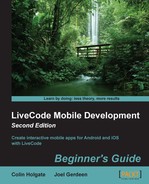Book Description
Create interactive mobile apps for Android and iOS with LiveCode
- Create fun, interactive apps with the rich media features of LiveCode
- Dive headfirst into mobile application development through explanations enriched with ample screenshots
- Learn to create apps and interfaces using the step-by-step instructions
In Detail
LiveCode is a tool for developing mobile apps designed for users who don't want to use Objective-C, C++, or Java. LiveCode Mobile Development Beginner's Guide, Second Edition will explain how to create apps and upload them to the app stores with minimal effort.
You will begin with a simple calculator application and quickly enhance it using LiveCode Mobile. You will also learn about the interface controls for videos and images of LiveCode's environment. You'll go on digging into configuring devices and making rich media applications, and then finish by uploading your mobile applications to app stores. You will learn how to build apps for iPhone and Android devices with LiveCode Mobile through sample applications of increasing complexity.
Downloading the example code for this book You can download the example code files for all Packt books you have purchased from your account at http://www.PacktPub.com. If you purchased this book elsewhere, you can visit http://www.PacktPub.com/support and register to have the files e-mailed directly to you.
Table of Contents
- LiveCode Mobile Development Beginner's Guide Second Edition
- Table of Contents
- LiveCode Mobile Development Beginner's Guide Second Edition
- Credits
- About the Authors
- About the Reviewers
- www.PacktPub.com
- Preface
- 1. LiveCode Fundamentals
- Background history and metaphors
- You do have LiveCode, don't you?
- Learning the lay of the land
- Time for action – it's a drag, but you'll like it!
- Time for action – making cards and navigating between them
- Making a simple calculator application
- Time for action – making the calculator buttons
- Other interface controls
- Debugging
- Summary
- 2. Getting Started with LiveCode Mobile
- iOS, Android, or both?
- Becoming an Android developer
- Becoming an iOS developer
- Before we make our first mobile app…
- Time for action – starting an Android Virtual Device
- Time for action – adding Kindle Fire to ADB
- Time for action – using the iOS simulator
- Appiness at last!
- Time for action – testing a simple stack in the simulators
- Time for action – testing a simple stack on devices
- Further reading
- Summary
- 3. Building User Interfaces
- Setting up a test bed mobile app
- Time for action – making the test bed stack
- Time for action – calling the native e-mail application
- Time for action – trying the test bed stack on devices
- Time for action – calling the native browser application
- The mobile-only date picker
- Time for action – displaying a date picker
- Time for action – loading pictures for a mobile device
- Making OS-styled buttons
- Time for action – using Photoshop to prepare button states
- MobGUI to the rescue!
- Time for action – getting started with MobGUI
- Time for action – using MobGUI to make a test bed app
- Time for action – using native controls from MobGUI
- Time for action – a simple code layout example
- Time for action – using the Geometry Manager to position buttons
- Resolution independence
- Summary
- 4. Using Remote Data and Media
- The stack structure
- Loading and saving external data
- Time for action – creating a data save stack
- Creating a web "scraper" app
- Time for action – setting up the tab navigation
- Time for action – adding the browser controls
- Time for action – making a links extraction function
- Time for action – adding the links card's init handler
- Time for action – setting up the Text card
- Time for action – extracting a list of media links
- Time for action – setting up the Media card scripts
- Time for action – setting up the Keepers card
- Summary
- 5. Making a Jigsaw Puzzle Application
- Image data format
- Misusing imageData
- Time for action – testing a getPixel function
- Time for action – making a map of the United States
- Time for action – making a racecourse
- Time for action – making a racecar
- Making a jigsaw puzzle
- Time for action – creating the pieces and choosing an image
- Time for action – transferring imageData
- Time for action – setting up touch events
- Summary
- 6. Making a Reminder Application
- Different types of reminders
- Timing of notifications
- Time for action – creating date and time pickers
- Where?
- Time for action – trying out native location tracking
- Information needed in a reminder
- Making the reminder app
- Time for action – creating the reminder app screens
- Time for action – adding stack-level functions
- Time for action – making the home card buttons work
- Time for action – making the location card work
- Time for action – taking in information about the reminder
- Summary
- 7. Deploying to Your Device
- A. Extending LiveCode
- Index
